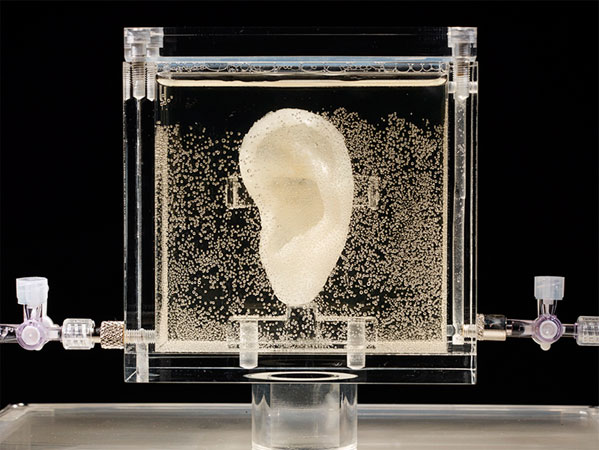
Undated picture shows an ear made of human cells grown from samples provided from a distant relative from Dutch artist Vincent van Gogh, in the center for art and media in Karlsruhe, Germany, Tuesday, June 3, 2014. US based artist Diemut Strebe said she wants to combine art and science with the installation. (AP Photo/Diemut Strebe.Sugababe)
BERLIN — A German museum has put on display a copy of Vincent van Gogh’s ear that was grown using genetic material provided by one of the 19th-century Dutch artist’s living relatives.
The Center for Art and Media in Karlsruhe said artist Diemut Strebe made the replica using living cells from Lieuwe van Gogh, the great-great-grandson of Vincent’s brother Theo.
Using a 3D-printer, the cells were shaped to resemble the ear that Vincent van Gogh is said to have cut off during a psychotic episode in 1888.
“I use science basically like a type of brush, like Vincent used paint,” Strebe told The Associated Press in a telephone interview Tuesday.
The U.S.-based artist said the ear, which was grown at Boston’s Brigham and Women’s Hospital, is being kept alive inside a case containing a nourishing liquid and could theoretically last for years.
Convincing Lieuwe van Gogh to take part was easy. “He loved the project right away,” said Strebe.
Lieuwe and Vincent van Gogh share about 1/16th of the same genes, including the Y-chromosome that is passed down the male lineage.
But hopes of using genetic material that belonged to the post-Impressionist master himself were dashed when DNA extracted from an envelope turned out to belong to someone else. “The postman messed it up,” Strebe joked.
Still, work is underway with a female relative to include mitochondrial DNA — passed down the mother’s line — for future installations.
The exhibition, at which visitors can speak into the ear through a microphone, lasts until July 6. Strebe said she plans to display the ear in New York next year.